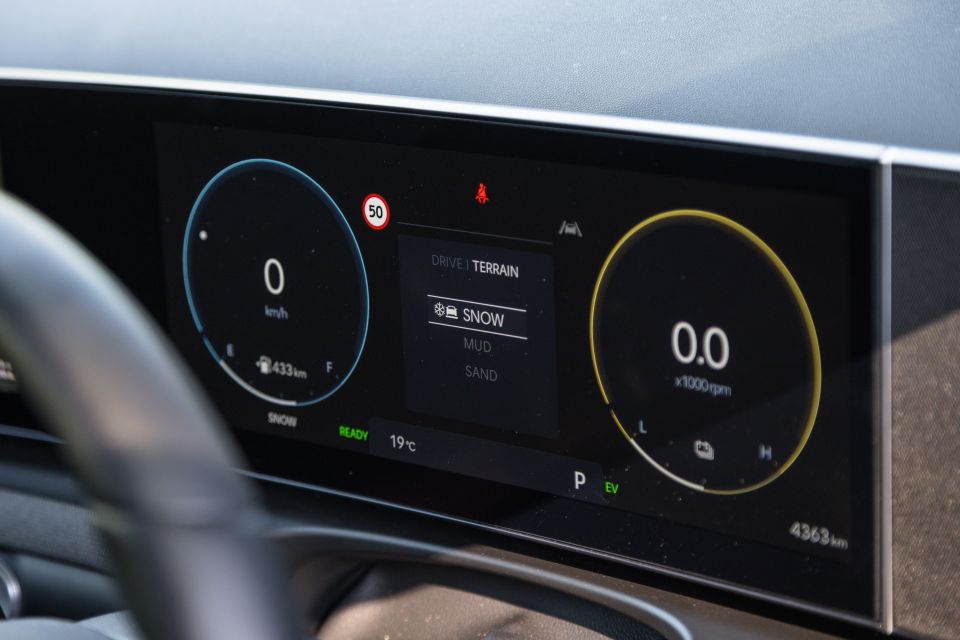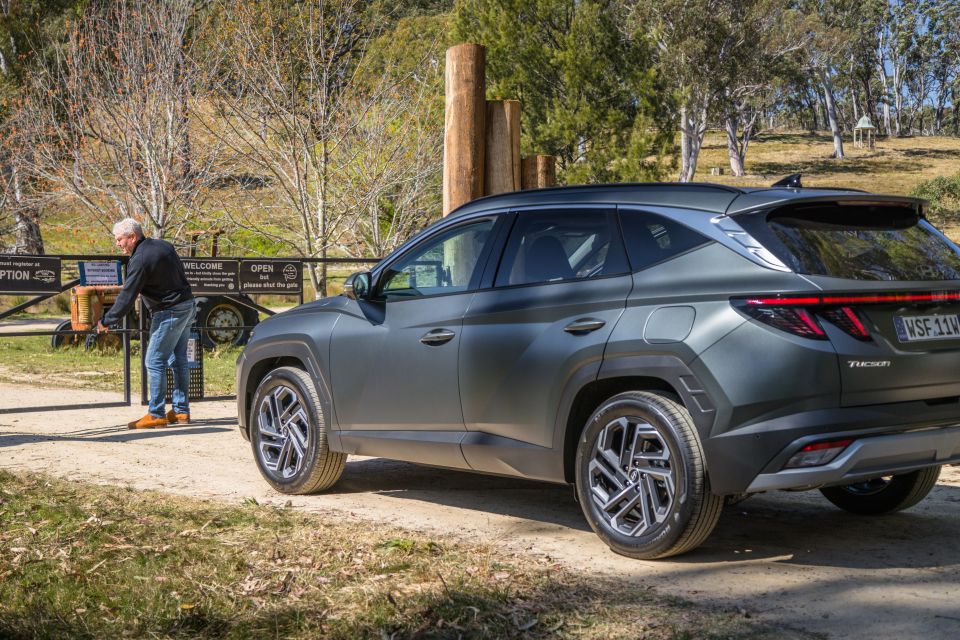

Andrew Maclean
Honda CR-V RS e:HEV vs Toyota RAV4 Edge Hybrid: Spec battle
14 Days Ago
SPONSORED: The Hyundai Tucson Hybrid is a genuine alternative to Toyota’s RAV4 Hybrid, and sets new benchmarks for refinement and performance.



Quickly see how this car stacks up against its competition. Select any benchmark to see more details.
Where expert car reviews meet expert car buying – CarExpert gives you trusted advice, personalised service and real savings on your next new car.
SPONSORED
While the fourth-generation Hyundai Tucson remained a buyer’s favourite from the moment it launched here in 2021, the newly-updated version of the popular mid-sized SUV is discernibly better again across all key areas.
Gone is the diesel option and in its place a high-tech hybrid for the first time in Australia, designed to deliver both efficiency gains as well strong all-round performance with seamless hybrid assistance.
While the facelifted Tucson range starts from just $39,100 excluding on-road costs for the front-wheel drive 2.0-litre petrol auto version, it’s bookended by the range-topping Tucson Hybrid Premium N Line AWD priced at $61,100 plus on roads.
For a recent trip up to the picturesque Blue Mountains we opted for the next rung down (not by much), the Tucson Hybrid Premium AWD priced from $59,600 before on-road costs.
Honestly, for the extra two grand, we’d likely stump up for the N Line version for its suede leather-appointed seat trim alone, never mind all the other goodies included with the sporty option pack.
The good news is the new petrol-electric hybrid drivetrain is available across all three trim grades – Tucson, Tucson Elite and Tucson Premium – as well as the N Line Option Pack.
Likewise, the N Line pack is also available across all three model grades, so there’s plenty of choice for all budgets across the rejuvenated Tucson lineup.


Nevertheless it’s not all about hybrid technology with Tucson’s mid-life update, either. This is a substantial reboot covering everything from styling, tech and dynamic performance, and all in equal measure.
Never before has there been such a convincing rival to Toyota’s RAV4 Hybrid in Australia. But when you factor in Tucson’s all-new cabin design – one that’s simply brimming with all the latest technology and big-ticket features – the Hyundai starts to look exceedingly good by comparison.
Kit such as new front and rear bumpers and styling treatments, LED headlights, a full-length rear light strip, dual curved interior screens with over-the-air updates, an all-new 6.6-inch separate climate control panel including proper temperature dials, and Hyundai’s clever Bluelink connectivity app – and that’s just from the entry-level.
Along with the feature fest, the new Tucson looks and feels like a classier proposition that its rivals. But step up to the Premium we drove here and it gives new meaning to the term affordable luxury.


Inside, it’s a big upgrade, especially at the upper level of the Tucson model range. The leather-appointed seats are first-class, offering exceptional comfort and support. With powered adjustment up front, it’s easy to find that perfect driving position or change it up a tad during longer drives.
The new dashboard is superb for its blend of premium materials and the very latest technology. There are dual screens in one curved housing offering crisp colour and graphics, and thanks to the latest NVIDIA CPU there’s four times more computing power and 15 times more graphical processing power than in the pre-updated Tucson.
Ergonomically, the facelifted Tucson is dream. The large infotainment touchscreen is angled towards the driver for great viewing and perfect reach. Gone is the console-mounted shifter, replaced by a shift-by-wire selector stalk that looks like it could have been designed by Italian company Alessi – such is the look and feel of this jewel-like control.
Not only is it incredibly intuitive (you just twist it forward for Drive or back for Reverse), but it also frees up a ton of handy storage space in the centre console, which includes a fast wireless charging pad with built-in cooling fan, and more storage receptacles than you could ever use.




The clean dash design, premium materials and switchgear, and the dual curved screens are stand-outs in this popular market segment. But when you add big-ticket items such as the panoramic glass sunroof, head-up display, Bose eight-speaker sound system, heated steering wheel, heated and cooled front seats and even heated rear outboard seats – there’s proper five-star luxury here.
If you’re a family of four or five and heading up to a place like the Megalong Valley for a family getaway like we did, you’re also going to be pleasantly surprised by the amount of cabin space and luggage capacity – in the Tucson Hybrid, particularly.
But that doesn’t have to mean it’s big on the outside or difficult to get around tight shopping centre carparks, either. On the contrary, the updated Tucson measures just 4640mm in length, so it isn’t massive by mid-sized SUV standards, but rear legroom, headroom and boot space are cavernous.
Interestingly, while boot space remains the same on the petrol versions (539L/1860L) that’s with a full-size spare. Hybrid versions get an extra 40 litres all round (582L/1903L) thanks to the space-saver spare under the floor.

You’ll also want to get in tune with Hyundai’s Bluelink Connected Car Services via the Bluelink app as soon as conveniently possible.
Ostensibly, the system allows remote control of a wide range of functions, including locking and unlocking the vehicle as well activating climate control, starting the car, and even cracking the windows to ventilate the vehicle on hot days – and plenty more from your smartphone as part of a transferrable five-year subscription with your purchase.
It’s brilliant tech and if you’re like me you’ll be using it on a daily basis.
Another clever facet of this updated Tucson are over-the-air (OTA) software updates, which are delivered to the car’s CPU wirelessly. It means you’ll get all the relevant software updates without the need to visit a dealership.

Once you’re on the go, you’ll likely appreciate the engineering that’s gone into the development of both the hybrid system and ride/handling almost immediately.
For starters, the 1.6-litre turbo-petrol hybrid offers significantly more punch than its closest rival. And, paired with a six-speed automatic transmission rather than a CVT, it’s also noticeably more refined with none of the whine or flaring than can affect CVTs.
The hybrid powertrain makes a solid 172kW of power and 367Nm of torque over a wide 1000-4100rpm – and believe me, on the road it feels every bit of that if not more. However, it tends to start in silence – in EV mode – and continues as such in situations like car parks or backing out of your driveway when minimal throttle is required.
To give that some perspective, it’s a lot more than the 132kW/264Nm outputs generated by the 1.6-litre turbo four without hybrid assistance, but the power comes on more smoothly and with less fuss too. It’s a very, very good hybrid system that’s clearly been engineered to deliver a seamless driving experience.

You’ve also got the efficiency gains that come with a hybrid drivetrain of this type – that’s 5.7L/100km of 91 RON on a recent trip from Sydney to Newcastle at the speed limit. Mind, the factory claim for purely urban driving dips as low as 5.3L/100km.
Again, it’s the integration of the two power sources that makes this Hyundai model such a rewarding experience, no matter what your driving habits might be.
It makes longer stints like ours up to the Megalong Valley from Sydney’s Northern Beaches far less tiring than you might otherwise experience in a rival model.
We were heading directly to the Megalong Valley Farm – just on from the Tea Rooms – which was once the favoured horse riding destination for city-slickers, but is now one of NSW’s most spectacular camping sites with views to die for and a bargain for just $30 per person. Just speak with Gary, Glenda or Kylie to get sorted – they’re the nicest people too.

Back behind the wheel and it’s not just the extra oomph you’ll experience with the newest Tucson Hybrid, it’s just as much about the superior driving dynamics and body control that go a long way to making it feel more premium and better-sorted than rivals.
Cornering is sure-footed with little lean in the faster bends, but there’s no compromise whatsoever to ride comfort over bumps and poorly maintained road surfaces. It feels like the benchmark in this regard.
Underneath, there are a lot of clever systems at play in the Tucson Hybrid to make it all feel so composed – whether you’re just on the daily commute or heading out of town.
One of them is e-Motion Drive, which is Hyundai’s electric Dynamic Torque Vectoring system that improves grip and traction during cornering.

But under that system there’s a full suite of dynamic control systems including e-Drive, which adds more driver-assistance tech with the likes of e-Handling, e-Traction and e-Dynamic Traction, all of which delivers rock-solid traction at higher speeds.
Additionally, there’s e-Comfort that ensures minimal front and rear pitch as well as delivering smoother acceleration. All of this is seamless to the driver. For new families there’s even Baby Mode – which takes it further again by minimising initial acceleration while maintaining forward progress. This system alone could easily be a Godsend.
Off-road excursions are a breeze in the Tucson Hybrid AWD thanks to its auto Terrain Mode, which also gives you Snow, Mud and Sand settings.
Of course, safety is also well-sorted on the latest Tucson thanks to Hyundai’s SmartSence suite, which includes no less that 21 active safety systems – at least by my count – and underpins the model’s five-star ANCAP safety rating.

With such an overarching improvement, it’s now difficult to find any faults (even minor ones) in the updated Tucson. It’s the higher level of refinement and technology, as well as the performance and efficiency gains, that should see the Tucson Hybrid go to the top of any Australian buyer’s mid-sized SUV shortlist.
Hybrid power is not just a game-changer for the Tucson nameplate, but for the entire Hyundai model range. The Tucson Hybrid lineup is a genuine threat to Toyota’s RAV4, and in my view the new segment benchmark in terms of both refinement and performance, quite apart from the uprated technology and ride/handling gains.
While we didn’t take a caravan along for this trip, we did manage to grab a rare booking at Foy’s Folly, a luxury two-bedroom home all on its own in the Megalong Valley with a backdrop that could easily claim to be one of the best panoramic views in Australia.
For the foodies, it’s a just short hop from the revered paddock-to-plate Megalong @ Lot 101, which is apparently an experience not to be missed.

Interested in buying a Hyundai Tucson? Get in touch with one of CarExpert’s trusted dealers here
Click the images for the full gallery
Where expert car reviews meet expert car buying – CarExpert gives you trusted advice, personalised service and real savings on your next new car.


Andrew Maclean
14 Days Ago


James Wong
11 Days Ago


Max Davies
9 Days Ago


Paul Maric
7 Days Ago


Max Davies
5 Days Ago


James Wong
4 Days Ago